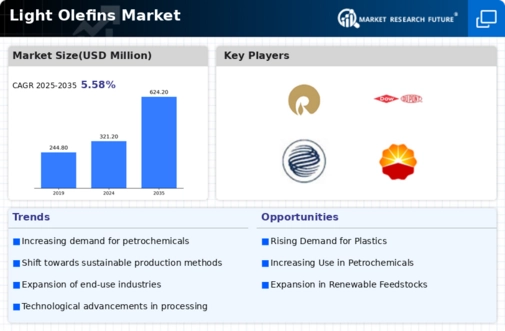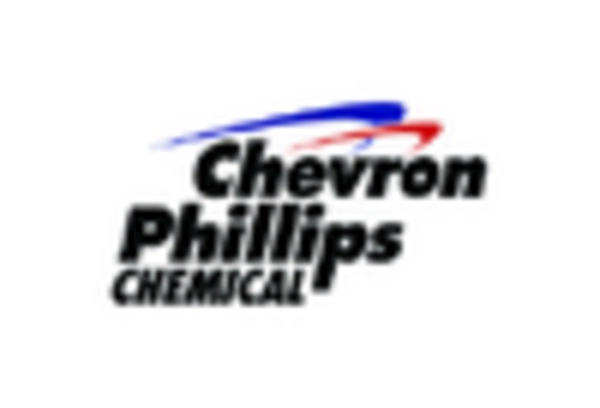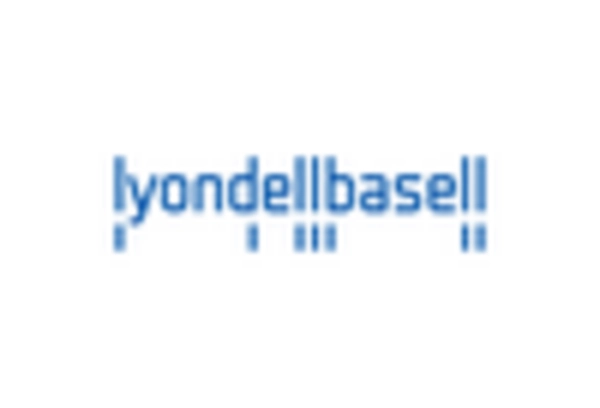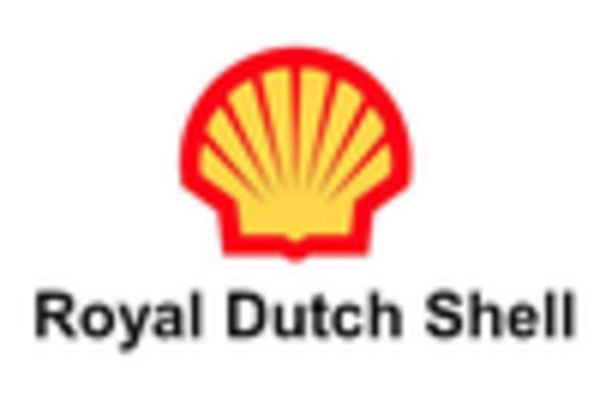-
Report Prologue
-
Scope Of The Report
-
Market Definition 17
-
The Scope Of The Study 17
- Research Objectives 17
- Assumptions 17
- Limitations 17
-
Market Structure 18
-
Research Methodology
-
Research Process 21
-
Primary Research 21
-
Secondary Research 21
-
Market Size Estimation 22
-
Forecast Model 23
-
Market Dynamics
-
Introduction 25
-
Drivers 26
- Increasing Demand For Polymer 26
- Excellent Conversion Of Light Olefins From Methanol 27
-
Restraint 28
- Ethylene Exposure To Air Affects The Environment 28
-
Opportunity 29
- Shale Gas Development 29
-
Trends 29
- Biomass Feedstock To Bio-Ethylene 29
-
Market Impact Analysis
-
Supply Chain Analysis 31
- Raw Material Suppliers 31
- Light Olefins Producers 31
- Distributors 32
- End User 32
-
-
Porter’s Five Forces 32
- Threat Of New Entrants 32
- The Intensity Of Competitive Rivalry 32
- Bargaining Power Of Supplier 32
- Bargaining Power Of Buyer 32
- Threat Of Substitute 32
-
Global Light Olefins Market, By Type
-
Ethylene 35
-
Propylene 36
-
Global Light Olefins Market, By Derivatives
-
Polypropylene 40
-
Propylene Oxide 41
-
Acrylonitrile 42
-
Cumene 43
-
Acrylic Acid 44
-
Oxo Alcohols 45
-
Polyethylene 46
-
Ethylene Oxide/Glycol 47
-
EDC/VCM/PVC 48
-
Styrene 49
-
Alpha Olefins 50
-
Vinyl Acetate Monomer 51
-
Global Light Olefins Market, By Application
-
Chemical Commodities 54
-
Refinery 55
-
Global Light Olefins Market, By Region
-
Introduction 57
-
North America 62
- US 66
- Canada 69
-
Europe 73
- Germany 78
- France 81
- UK 84
- Spain 87
- Italy 90
- Rest Of Europe 93
-
Asia Pacific 97
- China 101
- Japan 104
- India 107
- Rest Of Asia Pacific 110
-
Latin America 114
-
Middle East & Africa 119
-
Competitive Landscape
-
Introduction 125
- Market Strategy Overview 125
-
Key Development Analysis 126
- Expansion 126
- Acquisition 126
- Joint Venture 127
- Agreement 127
-
Company Profile
-
Royal Dutch Shell 129
- Company Overview 129
- Financials 129
- Products 129
- Strategy 129
- Key Developments 129
-
PetroChina 130
- Company Overview 130
- Financials 130
- Products 130
- Strategy 130
- Key Developments 130
-
Relience Industries Limited 131
- Company Overview 131
- Financials 131
- Products 131
- Strategy 131
- Key Developments 131
-
China Petro& Chemical Corp 132
- Company Overview 132
- Financials 132
- Products 132
- Strategy 132
- Key Developments 132
-
DowDuPont, Inc 133
- Company Overview 133
- Financials 133
- Products 133
- Strategy 133
- Key Developments 133
-
Exxon Mobil Corporation 134
- Company Overview 134
- Financials 134
- Products 134
- Strategy 134
- Key Developments 134
-
Gazprom 135
- Company Overview 135
- Financials 135
- Products 135
- Strategy 135
- Key Developments 135
-
Saudi Arabian Oil Co. 136
- Company Overview 136
- Financials 136
- Products 136
- Strategy 136
- Key Developments 136
-
BASF SE 137
- Company Overview 137
- Financials 137
- Products 137
- Strategy 137
- Key Developments 137
-
Honeywell International Inc 138
- Company Overview 138
- Financials 138
- Products 138
- Strategy 138
- Key Developments 138
-
Conclusion
-
List Of Tables
-
GLOBAL LIGHT OLEFINS MARKET, BY TYPE, 2020-2027 (USD BILLION) 34
-
GLOBAL LIGHT OLEFINS MARKET, BY TYPE, 2020-2027 (MILLION TONS) 35
-
GLOBAL LIGHT OLEFINS MARKET FOR ETHYLENE, 2020-2027 (USD BILLION) 35
-
GLOBAL LIGHT OLEFINS MARKET FOR ETHYLENE, 2020-2027 (MILLION TONS) 35
-
GLOBAL LIGHT OLEFINS MARKET FOR PROPYLENE, 2020-2027 (USD BILLION) 36
-
GLOBAL LIGHT OLEFINS MARKET FOR PROPYLENE, 2020-2027 (MILLION TONS) 36
-
GLOBAL LIGHT OLEFINS MARKET, BY DERIVATIVES, 2020-2027 (USD BILLION) 38
-
GLOBAL LIGHT OLEFINS MARKET, BY DERIVATIVES, 2020-2027 (MILLION TONS) 39
-
GLOBAL LIGHT OLEFINS MARKET FOR POLYPROPYLENE, 2020-2027 (USD BILLION) 40
-
GLOBAL LIGHT OLEFINS MARKET FOR POLYPROPYLENE, 2020-2027 (MILLION TONS) 40
-
GLOBAL LIGHT OLEFINS MARKET FOR PROPYLENE OXIDE, 2020-2027 (USD BILLION) 41
-
GLOBAL LIGHT OLEFINS MARKET FOR PROPYLENE OXIDE, 2020-2027 (MILLION TONS) 41
-
GLOBAL LIGHT OLEFINS MARKET FOR ACRYLONITRILE, 2020-2027 (USD BILLION) 42
-
GLOBAL LIGHT OLEFINS MARKET FOR ACRYLONITRILE, 2020-2027 (MILLION TONS) 42
-
GLOBAL LIGHT OLEFINS MARKET FOR CUMENE, 2020-2027 (USD BILLION) 43
-
GLOBAL LIGHT OLEFINS MARKET FOR CUMENE, 2020-2027 (MILLION TONS) 43
-
GLOBAL LIGHT OLEFINS MARKET FOR ACRYLIC ACID, 2020-2027 (USD BILLION) 44
-
GLOBAL LIGHT OLEFINS MARKET FOR ACRYLIC ACID, 2020-2027 (MILLION TONS) 44
-
GLOBAL LIGHT OLEFINS MARKET FOR OXO ALCOHOLS, 2020-2027 (USD BILLION) 45
-
GLOBAL LIGHT OLEFINS MARKET FOR OXO ALCOHOLS, 2020-2027 (MILLION TONS) 45
-
GLOBAL LIGHT OLEFINS MARKET FOR POLYETHYLENE, 2020-2027 (USD BILLION) 46
-
GLOBAL LIGHT OLEFINS MARKET FOR POLYETHYLENE, 2020-2027 (MILLION TONS) 46
-
GLOBAL LIGHT OLEFINS MARKET FOR ETHYLENE OXIDE/GLYCOL, 2020-2027 (USD BILLION) 47
-
GLOBAL LIGHT OLEFINS MARKET FOR ETHYLENE OXIDE/GLYCOL, 2020-2027 (MILLION TONS) 47
-
GLOBAL LIGHT OLEFINS MARKET FOR EDC/VCM/PVC, 2020-2027 (USD BILLION) 48
-
GLOBAL LIGHT OLEFINS MARKET FOR EDC/VCM/PVC, 2020-2027 (MILLION TONS) 48
-
GLOBAL LIGHT OLEFINS MARKET FOR STYRENE, 2020-2027 (USD BILLION) 49
-
GLOBAL LIGHT OLEFINS MARKET FOR STYRENE, 2020-2027 (MILLION TONS) 49
-
GLOBAL LIGHT OLEFINS MARKET FOR ALPHA OLEFINS, 2020-2027 (USD BILLION) 50
-
GLOBAL LIGHT OLEFINS MARKET FOR ALPHA OLEFINS, 2020-2027 (MILLION TONS) 50
-
GLOBAL LIGHT OLEFINS MARKET FOR VINYL ACETATE MONOMER, 2020-2027 (USD BILLION) 51
-
GLOBAL LIGHT OLEFINS MARKET FOR VINYL ACETATE MONOMER, 2020-2027 (MILLION TONS) 51
-
GLOBAL LIGHT OLEFINS MARKET, BY APPLICATION, 2020-2027 (USD BILLION) 53
-
GLOBAL LIGHT OLEFINS MARKET, BY APPLICATION, 2020-2027 (MILLION TONS) 54
-
GLOBAL LIGHT OLEFINS MARKET FOR CHEMICAL COMMODITIES, 2020-2027 (USD BILLION) 54
-
GLOBAL LIGHT OLEFINS MARKET FOR CHEMICAL COMMODITIES, 2020-2027 (USD BILLION) 54
-
GLOBAL LIGHT OLEFINS MARKET FOR REFINERY, 2020-2027 (USD BILLION) 55
-
GLOBAL LIGHT OLEFINS MARKET FOR REFINERY, 2020-2027 (USD BILLION) 55
-
GLOBAL LIGHT OLEFINS MARKET, BY REGION, 2020-2027 (USD BILLION) 57
-
GLOBAL LIGHT OLEFINS MARKET, BY REGION, 2020-2027 (MILLION TONS) 58
-
GLOBAL LIGHT OLEFINS MARKET, BY TYPE, 2020-2027 (USD BILLION) 58
-
GLOBAL LIGHT OLEFINS MARKET, BY TYPE, 2020-2027 (MILLION TONS) 59
-
GLOBAL LIGHT OLEFINS MARKET, BY DERIVATIVES, 2020-2027 (USD BILLION) 59
-
GLOBAL LIGHT OLEFINS MARKET, BY DERIVATIVES, 2020-2027 (MILLION TONS) 60
-
GLOBAL LIGHT OLEFINS MARKET, BY APPLICATION, 2020-2027 (USD BILLION) 60
-
GLOBAL LIGHT OLEFINS MARKET, BY APPLICATION, 2020-2027 (MILLION TONS) 61
-
NORTH AMERICA LIGHT OLEFINS MARKET, BY COUNTRY, 2020-2027 (USD BILLION) 63
-
NORTH AMERICA LIGHT OLEFINS MARKET, BY COUNTRY, 2020-2027 (MILLION TONS) 63
-
NORTH AMERICA LIGHT OLEFINS MARKET, BY TYPE, 2020-2027 (USD BILLION) 63
-
NORTH AMERICA LIGHT OLEFINS MARKET, BY TYPE, 2020-2027 (MILLION TONS) 64
-
NORTH AMERICA LIGHT OLEFINS MARKET, BY DERIVATIVES, 2020-2027 (USD BILLION) 64
-
NORTH AMERICA LIGHT OLEFINS MARKET, BY DERIVATIVES, 2020-2027 (MILLION TONS) 65
-
NORTH AMERICA LIGHT OLEFINS MARKET, BY APPLICATION, 2020-2027 (USD BILLION) 65
-
NORTH AMERICA LIGHT OLEFINS MARKET, BY APPLICATION, 2020-2027 (MILLION TONS) 66
-
US LIGHT OLEFINS MARKET, BY TYPE, 2020-2027 (USD BILLION) 66
-
US LIGHT OLEFINS MARKET, BY TYPE, 2020-2027 (MILLION TONS) 66
-
US LIGHT OLEFINS MARKET, BY DERIVATIVES, 2020-2027 (USD BILLION) 67
-
US LIGHT OLEFINS MARKET, BY DERIVATIVES, 2020-2027 (MILLION TONS) 68
-
US LIGHT OLEFINS MARKET, BY APPLICATION, 2020-2027 (USD BILLION) 68
-
US LIGHT OLEFINS MARKET, BY APPLICATION, 2020-2027 (MILLION TONS) 69
-
CANADA LIGHT OLEFINS MARKET, BY TYPE, 2020-2027 (USD BILLION) 69
-
CANADA LIGHT OLEFINS MARKET, BY TYPE, 2020-2027 (MILLION TONS) 69
-
CANADA LIGHT OLEFINS MARKET, BY DERIVATIVES, 2020-2027 (USD BILLION) 70
-
CANADA LIGHT OLEFINS MARKET, BY DERIVATIVES, 2020-2027 (MILLION TONS) 71
-
CANADA LIGHT OLEFINS MARKET, BY APPLICATION, 2020-2027 (USD BILLION) 71
-
CANADA LIGHT OLEFINS MARKET, BY APPLICATION, 2020-2027 (MILLION TONS) 72
-
EUROPE LIGHT OLEFINS MARKET, BY COUNTRY, 2020-2027 (USD BILLION) 74
-
EUROPE LIGHT OLEFINS MARKET, BY COUNTRY, 2020-2027 (MILLION TONS) 74
-
EUROPE LIGHT OLEFINS MARKET, BY TYPE, 2020-2027 (USD BILLION) 75
-
EUROPE LIGHT OLEFINS MARKET, BY TYPE, 2020-2027 (MILLION TONS) 75
-
EUROPE LIGHT OLEFINS MARKET, BY DERIVATIVES, 2020-2027 (USD BILLION) 76
-
EUROPE LIGHT OLEFINS MARKET, BY DERIVATIVES, 2020-2027 (MILLION TONS) 77
-
EUROPE LIGHT OLEFINS MARKET, BY APPLICATION, 2020-2027 (USD BILLION) 77
-
EUROPE LIGHT OLEFINS MARKET, BY APPLICATION, 2020-2027 (MILLION TONS) 78
-
GERMANY LIGHT OLEFINS MARKET, BY TYPE, 2020-2027 (USD BILLION) 78
-
GERMANY LIGHT OLEFINS MARKET, BY TYPE, 2020-2027 (MILLION TONS) 78
-
GERMANY LIGHT OLEFINS MARKET, BY DERIVATIVES, 2020-2027 (USD BILLION) 79
-
GERMANY LIGHT OLEFINS MARKET, BY DERIVATIVES, 2020-2027 (MILLION TONS) 80
-
GERMANY LIGHT OLEFINS MARKET, BY APPLICATION, 2020-2027 (USD BILLION) 80
-
GERMANY LIGHT OLEFINS MARKET, BY APPLICATION, 2020-2027 (MILLION TONS) 81
-
FRANCE LIGHT OLEFINS MARKET, BY TYPE, 2020-2027 (USD BILLION) 81
-
FRANCE LIGHT OLEFINS MARKET, BY TYPE, 2020-2027 (MILLION TONS) 81
-
FRANCE LIGHT OLEFINS MARKET, BY DERIVATIVES, 2020-2027 (USD BILLION) 82
-
FRANCE LIGHT OLEFINS MARKET, BY DERIVATIVES, 2020-2027 (MILLION TONS) 83
-
FRANCE LIGHT OLEFINS MARKET, BY APPLICATION, 2020-2027 (USD BILLION) 83
-
FRANCE LIGHT OLEFINS MARKET, BY APPLICATION, 2020-2027 (MILLION TONS) 84
-
UK LIGHT OLEFINS MARKET, BY TYPE, 2020-2027 (USD BILLION) 84
-
UK LIGHT OLEFINS MARKET, BY TYPE, 2020-2027 (MILLION TONS) 84
-
UK LIGHT OLEFINS MARKET, BY DERIVATIVES, 2020-2027 (USD BILLION) 85
-
UK LIGHT OLEFINS MARKET, BY DERIVATIVES, 2020-2027 (MILLION TONS) 86
-
UK LIGHT OLEFINS MARKET, BY APPLICATION, 2020-2027 (USD BILLION) 86
-
UK LIGHT OLEFINS MARKET, BY APPLICATION, 2020-2027 (MILLION TONS) 87
-
SPAIN LIGHT OLEFINS MARKET, BY TYPE, 2020-2027 (USD BILLION) 87
-
SPAIN LIGHT OLEFINS MARKET, BY TYPE, 2020-2027 (MILLION TONS) 87
-
SPAIN LIGHT OLEFINS MARKET, BY DERIVATIVES, 2020-2027 (USD BILLION) 88
-
SPAIN LIGHT OLEFINS MARKET, BY DERIVATIVES, 2020-2027 (MILLION TONS) 89
-
SPAIN LIGHT OLEFINS MARKET, BY APPLICATION, 2020-2027 (USD BILLION) 89
-
SPAIN LIGHT OLEFINS MARKET, BY APPLICATION, 2020-2027 (MILLION TONS) 90
-
ITALY LIGHT OLEFINS MARKET, BY TYPE, 2020-2027 (USD BILLION) 90
-
ITALY LIGHT OLEFINS MARKET, BY TYPE, 2020-2027 (MILLION TONS) 90
-
ITALY LIGHT OLEFINS MARKET, BY DERIVATIVES, 2020-2027 (USD BILLION) 91
-
ITALY LIGHT OLEFINS MARKET, BY DERIVATIVES, 2020-2027 (MILLION TONS) 92
-
ITALY LIGHT OLEFINS MARKET, BY APPLICATION, 2020-2027 (USD BILLION) 92
-
ITALY LIGHT OLEFINS MARKET, BY APPLICATION, 2020-2027 (MILLION TONS) 93
-
REST OF EUROPE LIGHT OLEFINS MARKET, BY TYPE, 2020-2027 (USD BILLION) 93
-
REST OF EUROPE LIGHT OLEFINS MARKET, BY TYPE, 2020-2027 (MILLION TONS) 93
-
REST OF EUROPE LIGHT OLEFINS MARKET, BY DERIVATIVES, 2020-2027 (USD BILLION) 94
-
REST OF EUROPE LIGHT OLEFINS MARKET, BY DERIVATIVES, 2020-2027 (MILLION TONS) 95
-
REST OF EUROPE LIGHT OLEFINS MARKET, BY APPLICATION, 2020-2027 (USD BILLION) 95
-
REST OF EUROPE LIGHT OLEFINS MARKET, BY APPLICATION, 2020-2027 (MILLION TONS) 96
-
ASIA PACIFIC LIGHT OLEFINS MARKET, BY COUNTRY, 2020-2027 (USD BILLION) 98
-
ASIA PACIFIC LIGHT OLEFINS MARKET, BY COUNTRY, 2020-2027 (MILLION TONS) 98
-
ASIA PACIFIC LIGHT OLEFINS MARKET, BY TYPE, 2020-2027 (USD BILLION) 98
-
ASIA PACIFIC LIGHT OLEFINS MARKET, BY TYPE, 2020-2027 (MILLION TONS) 99
-
ASIA PACIFIC LIGHT OLEFINS MARKET, BY DERIVATIVES, 2020-2027 (USD BILLION) 99
-
ASIA PACIFIC LIGHT OLEFINS MARKET, BY DERIVATIVES, 2020-2027 (MILLION TONS) 100
-
ASIA PACIFIC LIGHT OLEFINS MARKET, BY APPLICATION, 2020-2027 (USD BILLION) 100
-
ASIA PACIFIC LIGHT OLEFINS MARKET, BY APPLICATION, 2020-2027 (MILLION TONS) 101
-
CHINA LIGHT OLEFINS MARKET, BY TYPE, 2020-2027 (USD BILLION) 101
-
CHINA LIGHT OLEFINS MARKET, BY TYPE, 2020-2027 (MILLION TONS) 101
-
CHINA LIGHT OLEFINS MARKET, BY DERIVATIVES, 2020-2027 (USD BILLION) 102
-
CHINA LIGHT OLEFINS MARKET, BY DERIVATIVES, 2020-2027 (MILLION TONS) 103
-
CHINA LIGHT OLEFINS MARKET, BY APPLICATION, 2020-2027 (USD BILLION) 103
-
CHINA LIGHT OLEFINS MARKET, BY APPLICATION, 2020-2027 (MILLION TONS) 104
-
JAPAN LIGHT OLEFINS MARKET, BY TYPE, 2020-2027 (USD BILLION) 104
-
JAPAN LIGHT OLEFINS MARKET, BY TYPE, 2020-2027 (MILLION TONS) 105
-
JAPAN LIGHT OLEFINS MARKET, BY DERIVATIVES, 2020-2027 (USD BILLION) 106
-
JAPAN LIGHT OLEFINS MARKET, BY DERIVATIVES, 2020-2027 (MILLION TONS) 106
-
JAPAN LIGHT OLEFINS MARKET, BY APPLICATION, 2020-2027 (USD BILLION) 107
-
JAPAN LIGHT OLEFINS MARKET, BY APPLICATION, 2020-2027 (MILLION TONS) 107
-
INDIA LIGHT OLEFINS MARKET, BY TYPE, 2020-2027 (USD BILLION) 107
-
INDIA LIGHT OLEFINS MARKET, BY TYPE, 2020-2027 (MILLION TONS) 108
-
INDIA LIGHT OLEFINS MARKET, BY DERIVATIVES, 2020-2027 (USD BILLION) 108
-
INDIA LIGHT OLEFINS MARKET, BY DERIVATIVES, 2020-2027 (MILLION TONS) 109
-
INDIA LIGHT OLEFINS MARKET, BY APPLICATION, 2020-2027 (USD BILLION) 109
-
INDIA LIGHT OLEFINS MARKET, BY APPLICATION, 2020-2027 (MILLION TONS) 110
-
REST OF ASIA PACIFIC LIGHT OLEFINS MARKET, BY TYPE, 2020-2027 (USD BILLION) 110
-
REST OF ASIA PACIFIC LIGHT OLEFINS MARKET, BY TYPE, 2020-2027 (MILLION TONS) 110
-
REST OF ASIA PACIFIC LIGHT OLEFINS MARKET, BY DERIVATIVES, 2020-2027 (USD BILLION) 111
-
REST OF ASIA PACIFIC LIGHT OLEFINS MARKET, BY DERIVATIVES, 2020-2027 (MILLION TONS) 112
-
REST OF ASIA PACIFIC LIGHT OLEFINS MARKET, BY APPLICATION, 2020-2027 (USD BILLION) 112
-
REST OF ASIA PACIFIC LIGHT OLEFINS MARKET, BY APPLICATION, 2020-2027 (MILLION TONS) 113
-
LATIN AMERICA LIGHT OLEFINS MARKET, BY TYPE, 2020-2027 (USD BILLION) 115
-
LATIN AMERICA LIGHT OLEFINS MARKET, BY TYPE, 2020-2027 (MILLION TONS) 115
-
LATIN AMERICA LIGHT OLEFINS MARKET, BY DERIVATIVES, 2020-2027 (USD BILLION) 116
-
LATIN AMERICA LIGHT OLEFINS MARKET, BY DERIVATIVES, 2020-2027 (MILLION TONS) 117
-
LATIN AMERICA LIGHT OLEFINS MARKET, BY APPLICATION, 2020-2027 (USD BILLION) 117
-
LATIN AMERICA LIGHT OLEFINS MARKET, BY APPLICATION, 2020-2027 (MILLION TONS) 118
-
MIDDLE EAST & AFRICA LIGHT OLEFINS MARKET, BY TYPE, 2020-2027 (USD BILLION) 120
-
MIDDLE EAST & AFRICA LIGHT OLEFINS MARKET, BY TYPE, 2020-2027 (MILLION TONS) 120
-
MIDDLE EAST & AFRICA LIGHT OLEFINS MARKET, BY DERIVATIVES, 2020-2027 (USD BILLION) 121
-
MIDDLE EAST & AFRICA LIGHT OLEFINS MARKET, BY DERIVATIVES, 2020-2027 (MILLION TONS) 122
-
MIDDLE EAST & AFRICA LIGHT OLEFINS MARKET, BY APPLICATION, 2020-2027 (USD BILLION) 122
-
MIDDLE EAST & AFRICA LIGHT OLEFINS MARKET, BY APPLICATION, 2020-2027 (MILLION TONS) 123
-
List Of Figures
-
TOP DOWN & BOTTOM-UP APPROACH 22
-
FORECAST MODEL 23
-
DRIVERS, RESTRAINT, OPPORTUNITY, AND TREND OF GLOBAL LIGHT OLEFINSMARKET 25
-
SUPPLY CHAIN ANALYSIS 31
-
GLOBAL LIGHT OLEFINS MARKET, BY TYPE, 2020-2027 (USD BILLION) 34
-
GLOBAL LIGHT OLEFINS MARKET, BY TYPE, 2020-2027 (MILLION TONS) 34
-
GLOBAL LIGHT OLEFINS MARKET, BY DERIVATIVES, 2020-2027 (USD BILLION) 38
-
GLOBAL LIGHT OLEFINS MARKET, BY DERIVATIVES, 2020-2027 (MILLION TONS) 39
-
GLOBAL LIGHT OLEFINS MARKET, BY APPLICATION, 2020-2027 (USD BILLION) 53
-
GLOBAL LIGHT OLEFINS MARKET, BY APPLICATION, 2020-2027 (MILLION TONS) 53
-
GLOBAL LIGHT OLEFINS MARKET, BY REGION, 2020-2027 (USD BILLION) 57
-
GLOBAL LIGHT OLEFINS MARKET, BY REGION, 2020-2027 (MILLION TONS) 58

















Leave a Comment